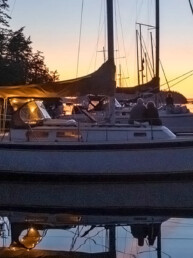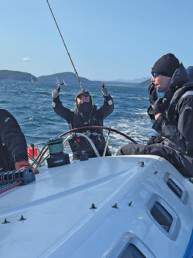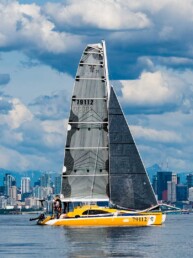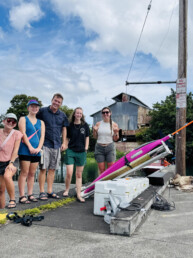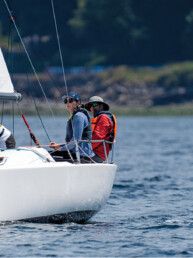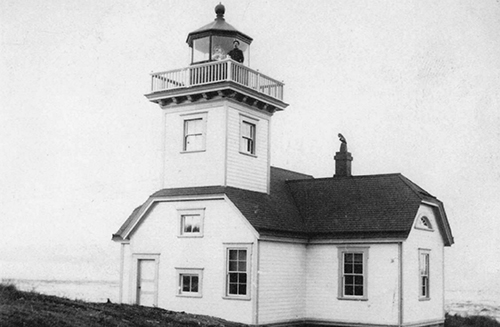
Boaters venturing north beyond the bustle of Friday Harbor, Roche Harbor, Deer Harbor, and other popular destinations in the San Juan archipelago will find a different world. Quiet and remote, the outer islands have a unique look and feel. Here eerie sandstone formations dot undeveloped shorelines, set against the vast backdrop of the Strait of Georgia.
“They sit low, aloof, wave-washed … and alluring,” wrote one observer of these islands (William Dietrich, Seattle Times August 18, 2002). It seems the perfect location for a lighthouse. Patos, the northernmost of the San Juan Islands, is home to a beacon that has guided mariners through Boundary Pass between Canada and the United States since 1893. According to one historian, this is the “most important” light in the San Juans (Lucile McDonald, Seattle Times, June 21, 1959).
Indigenous peoples call this island “Tl’x’óy7ten” or “Klu-whit-eton,” the place of harvesting oysters. Spanish explorers named it “Isla de Patos,” or island of ducks. As international vessel traffic increased in the late 19th century, Alaska steamers and vessels associated with coal and railroad shipping encountered treacherous conditions — swirling water, swift currents, and heavy fog — when passing the island. By 1888, Canada’s East Point Light had been established on Saturna Island on the British Columbia side of Boundary Pass and the need for a similar American lighthouse across from it became apparent.
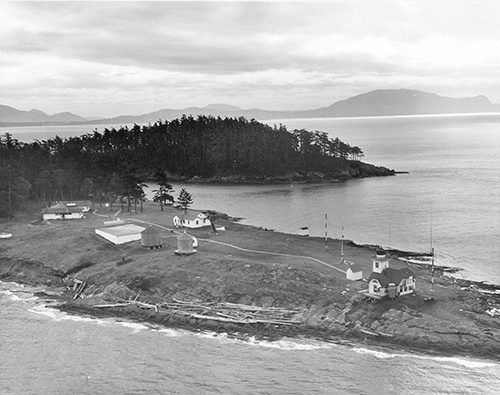
The Light Station
The light station on Patos Island, which sat opposite the beacon on Saturna Island, became operational late in 1893. It included a fog signal building, a two-story residence for the keepers, water tanks, and a post light (lamp on a stake). While the Canadian East Point Light flashed white, the beacon at Patos Island initially used a red signal. During the next two decades, deficiencies in this equipment led to more robust replacements and improvements. A longer trumpet was installed in the fog signal, for instance, and in 1900 duplicate oil engines replaced the steam engines too weak to run the compressors. The light, not always visible in adverse conditions, was replaced in 1908 by a revolving fourth-order Fresnel lens that flashed white, housed in a new 38-foot tower added to the original building.
The light station, designed by Carl Leick, was constructed of wood in the Greek Revival style, painted white. Its square tower included a striking walkway and railing that overlooked the water. Located at Alden Point on the northwestern tip of the island, it remained one of the most isolated beacons in the Salish Sea.

The Light Keepers
Life at the light station was characterized by distance from amenities and lack of communication with the outside world. Early keepers sometimes rowed or sailed to Eastsound on Orcas Island or Bellingham for supplies, and emergencies were broadcast by turning the station’s U.S. flag upside down – a signal that could be missed by passing ships. The closest neighbor was the keeper at Saturna Island, several miles across the water.
Harry Mahler, Patos’ first head keeper, arrived on Patos Island in 1893 and remained for nearly a decade. He brought his wife Louise, who was just 18 years old when she moved into the keeper’s residence with her husband. While two children were born on the island, Louise had her third child at a house rented on Eastsound. Her husband, who could not leave his post at the light station, learned of his daughter’s birth when a large bonfire on North Beach announced the event. Eventually the Mahlers moved to the Alki Point Lighthouse in Seattle. (See 48° North, May 2022 issue for more information on the Mahlers and how much they loved lighthouse life.)
Edward Durgan, who served as the assistant keeper, also arrived in 1893 but left soon after for assignments at other light stations in Washington and Oregon. In 1905 he returned to Patos with his wife Estelle and many of his 13 children, at least one of whom died on the island from smallpox or appendicitis (conflicting stories appear in multiple accounts). The details of the illness seem less significant than the recognition that life on this secluded outpost was fraught with peril. Additional tragedy struck in 1911, when Noah Clark, Durgan’s son-in-law and an assistant keeper, drowned during a winter storm while attempting to get his wife, son, and her sister to shore in the station’s launch, which had lost engine power and was filling with water. The other passengers were rescued the next day. For all these hardships, Durgan’s daughter recounted happy childhood memories of exploring the island’s tidepools and caves in her book, The Light on the Island (Helene Durgan Glidden, originally published in 1951).
George Lonholt, a single man who became head keeper in 1911, experienced difficulties of a different sort, quarreling with the assistant keeper, also a single man. The two keepers demonstrated how living in isolation and close quarters could amplify grievances. As the situation escalated, the assistant threatened to kill Lonholt, who left the island in fear for his life. Discovering that he could not perform the lighthouse duties alone, the assistant hoisted a distress signal, falsely reporting that his partner showed signs of insanity and had stolen a launch and fled. Upon investigation, the lighthouse inspector from Portland exonerated Lonholt and suspended the assistant. Lonholt continued as head keeper, distinguishing himself when he aided several disabled vessels, including the Verona, providing shelter on Patos Island to its 10 passengers during a storm.
In 1939, the US Coast Guard and Lighthouse Service merged, bringing a new era to Patos Island. Even so, the isolation of the outpost continued to require self-sufficiency and resourcefulness. Don Fox, a coast guardsman stationed at Patos, recalled that storms sometimes prevented supply runs — and cooking with limited ingredients could be difficult. Fox’s first attempt at baking bread was a failure. When the other men refused to eat his biscuits he offered them to the lighthouse dog, who also rejected them. Discouraged, Fox tossed the biscuits where he thought the gulls would eat them — and even the birds would not touch them. “The good news is Dad did eventually become a very good cook,” his daughter recalled (History Nook, Eileen Lorenz, 2017)
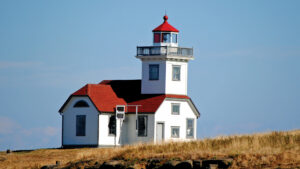
The Lighthouse Today
Lighthouse employees left Patos Island when the station became automated in 1974, and many buildings were removed. Patos is now part of San Juan Islands National Monument, established in 2013. Today, boaters can explore this historic island and view its restored and still-active lighthouse. Watch for the white flash every six seconds and for the two red sectors that mark Six Fathom Shoal and Rosenfield Rock to the west.
Cheryl McChesney, owner of Blue Water Yachts and a longtime Northwest sailor, recently looked back on her first trip to Patos, where she battled the swirling water. “I was not very experienced then and had not checked tides and currents,” she recalled. “There, at the front of the lighthouse, was the biggest whirlpool I had ever seen…I thought it would suck our boat down!” She tied up at one of the buoys at Active Cove, operated by Washington State Parks. “Beautiful island with so much sea life,” she commented. “It was how I remembered Sucia used to be.”
For more information, see www.parks.wa.gov/561/Patos-Island
Lisa Mighetto is a historian and sailor residing in Seattle.


